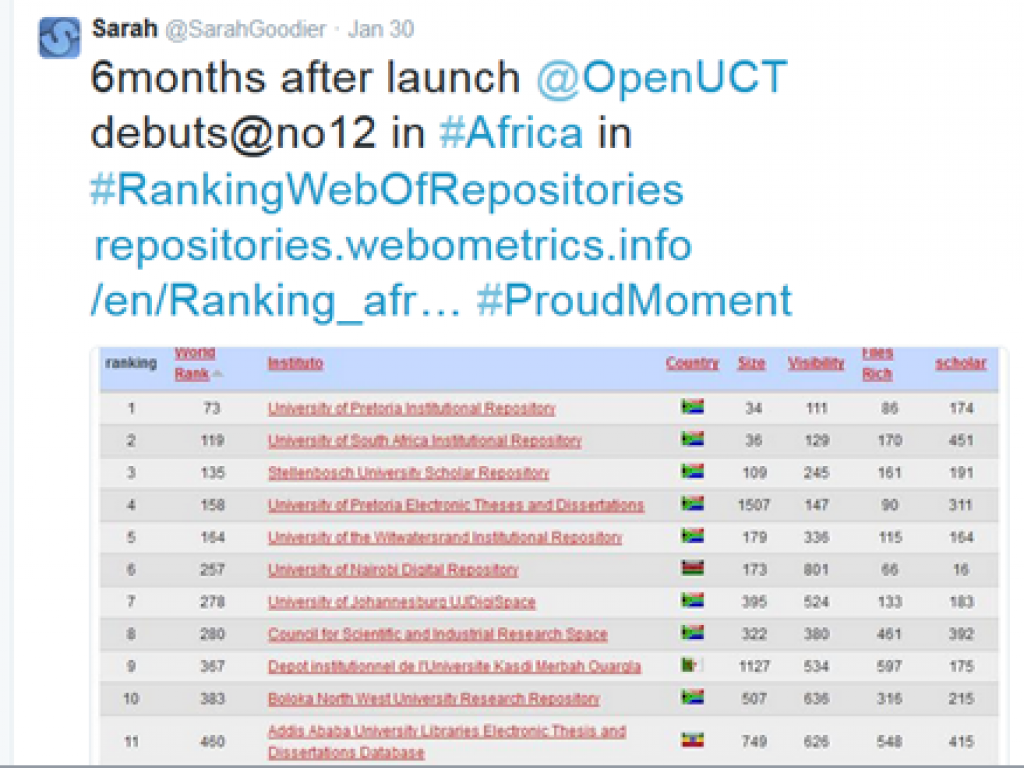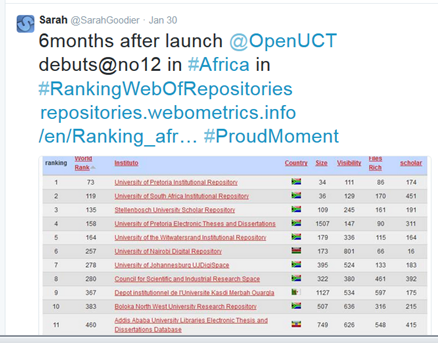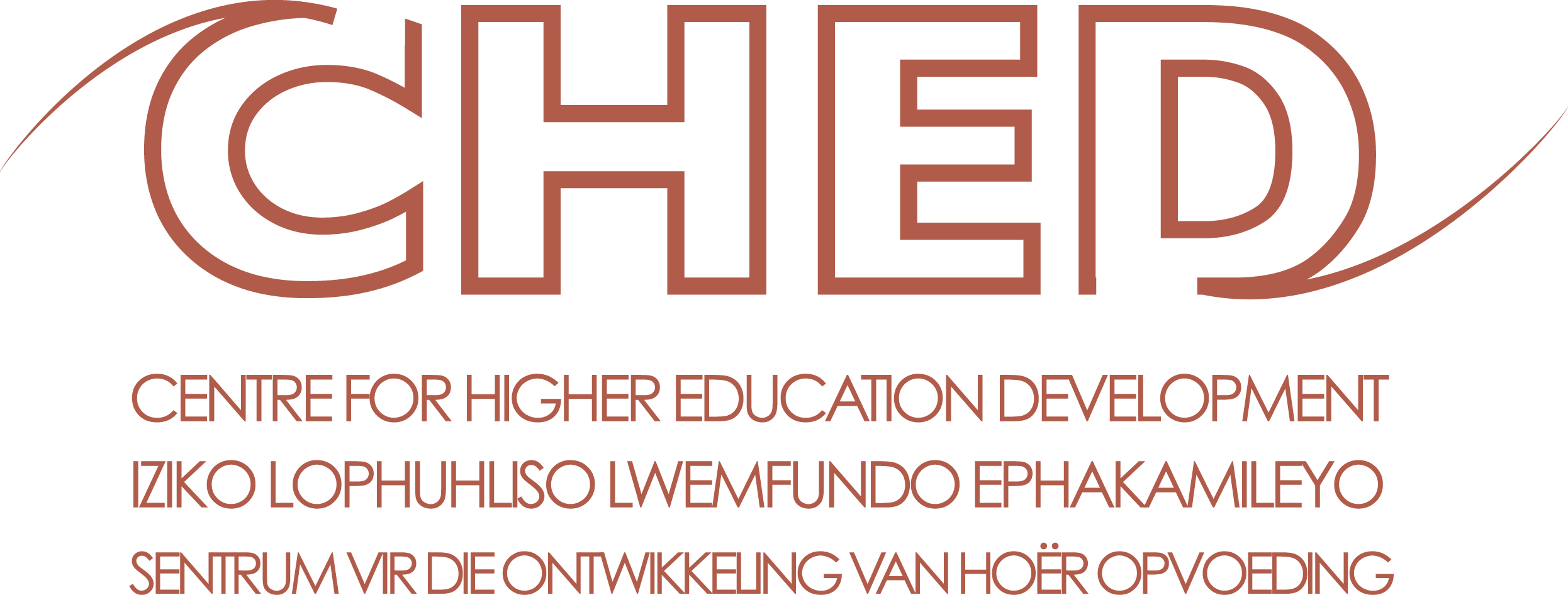CHED is making an impact

By Janine Dunlop and Laura Czerniewicz
It has been nine months since the launch of the OpenUCT repository and almost three months since we handed it over to UCT Libraries. Since we poured our heart and soul into this project, we’re interested to see how the repository is faring, so we requested some statistics from the Libraries’ web developer, David de la Croes. What we found is heartening: the repository is thriving.
We were not terribly surprised by the repository’s success. In January, Sarah Goodier tweeted the following:

What this means is that we got it right in terms of how the repository was set up. It is openly accessible to the public and visible via Google Scholar. The repository is being linked to from a variety of other web sites and it contains a range of content that is being downloaded by people from all over the world.
This in itself is encouraging. But what the statistics provided by the Libraries prove is that CHED research output and teaching and learning materials are being viewed and downloaded, in some cases, multiple times. Really exciting is that CHED outputs feature in the top five most viewed items on the repository as a whole.
David reports that the figures are not 100% reliable, as in some cases, items have multiple components, and only the first is counted. However, if a little incomplete, they provide an good picture of downloads and views associated with each item on the repository since its launch.
Guidelines are popular
Overall, there have been 65606 views of items on the repository and 39980 downloads since its launch.
The most viewed item, with 3076 views, is a publication by CHED staffers, Kyle Rother, Sarah Goodier, Lena Nyahodza, and Laura Czerniewicz called Curation for participation: an eight-step guide to curating open scholarly content. This is interesting as it indicates the high level of interest in managing online content.
Third place, with 2446 views and 369 downloads, is occupied by another CHED publication called Studying at University: a guide for first year students, by Catherine Hutchings and Stacey Stent. This Guide continues to go strong after several years.
In fourth place, with 2055 views, is Sarah Goodier and Laura Czerniewicz’s publication, Academics' online presence: a four-step guide to taking control of your visibility, an indication of academic awareness of their digital identities.
In total, CHED publications featured 24 times in the top 100 most viewed items.
Most downloaded Teaching & Learning items
People might view the metadata of an item but not download it. Or they might download the item from another web site. Here are some figures about how many times CHED publications were downloaded:
Desiree McKie and Jane Nash’s Introduction to Microsoft PowerPoint 2007 was the most downloaded item since the repository’s launch, attracting a whopping 4697 downloads.
The next most downloaded item was an infographic by CHED staffers, Cheryl Hodgkinson-Williams, Rondine Carstens, Tess Cartmill, Sukaina Walji, and Thomas King, called Research on Open Educational Resources for Development (ROER4D) Infographic - June 2014 which garnered 1874 downloads.
The third most downloaded item was another infographic about Creative Commons licences by Shihaam Donnelly, who used to be employed by CHED. This item drew 917 downloads.
In total, CHED featured 68 times in the top 100 most downloaded items in OpenUCT’s repository.
Let’s not forget research!
CHED research publications, such as article post- and preprints, feature 12 times in the top 100 most downloaded items on the repository. Here are 5 CHED publications that feature in the top 100 most downloaded items:
· Cheryl Hodgkinson-Williams’s conference paper, Degrees of ease: adoption of OER, open textbooks and MOOCs in the Global South, has had 190 downloads and 141 views.
· A research article postprint by Meryl Glaser and Ermien Van Pletzen called Inclusive education for deaf students: literacy practices and South African sign language was downloaded 179 times and viewed 89 times.
· An article published in Lexicos and written by Mbulugeni Madiba and Dion Nkomo, called The Tshivenda-English Thalusamaipfi/dictionary as a product of South African lexicographic processes received 153 downloads and 37 views.
· Laura Czerniewicz and Kelsey Wiens published the article, The online visibility of South African knowledge: searching for poverty alleviation in The African Journal of Information and Communication in 2013 and this item has received 103 downloads and 69 views on the repository.
· An article published by Nadia Hartman, et al, called Health sciences undergraduate education at University of Cape Town: a story of transformation, has been downloaded 93 times and viewed 139 times.
CHED research publications can also be found 18 times in the top 100 most viewed items. These items involve research on language and academic achievement, plagiarism, net-based learning, e-learning, facilitating adjustment to higher education, online visibility of academics, and quantitative literacy. Several CHED authors have more than one paper with high views and downloads.
Open access at work
We think these figures are very encouraging and a testament to the fact that open access works and is valuable for ensuring that our output is accessible to all. It is exciting that all types of CHED outputs are doing well: teaching and learning; research and popular resources. We’ll be keeping an eye on the repository stats in the future and hope to see further evidence of the success of CHED’s work.
